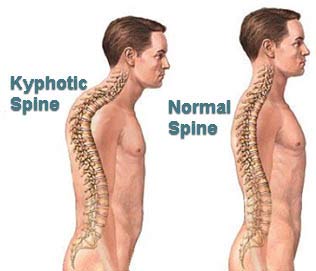 |
| Kyphosis Physiotherapy exercise |
This article describes some of the exercises that people can use to manage kyphosis. Physical therapy is especially helpful in cases of postural kyphosis because a physical therapist can help you learn how to correct your posture and strengthen your spinal muscles. A physical therapist can also help you learn how to exercise safely for kyphosis. Physical therapy will not correct a kyphotic curve caused by vertebral fractures, but learning correct (or better) posture can help prevent multiple fractures.
Both postural kyphosis and Schörmann's kyphosis can be improved by doing physical therapy exercises and maintaining good posture. Physiotherapy treatment may also be recommended for patients with structural kyphosis, including Scheuermann's kyphosis and kyphosis due to vertebral fractures. By targeting and correcting postural kyphosis, these exercises can also be recommended for overall strength and flexibility.
When combined with kyphosis-specific chiropractic, spinal extensor exercises can help achieve corrective effects by restoring spinal biomechanics, strength, and flexibility. Spinal stretching exercises strengthen the back muscles and make them more capable of resisting straight spinal traction conditions, which means that exercises that help strengthen the spinal extensor muscles can help reduce the angle of kyphosis in patients. This means that exercises that strengthen the extensor muscles can reduce the kyphosis. In the presence of kyphosis, adults can improve the position of the spine with exercises that strengthen the abdominal muscles and back extensors (muscles that help you stand and lift objects).
Exercise combined with good posture and chiropractic can help improve a rounded upper back. Try these five exercises that Araza recommends to help prevent or improve a rounded upper back.
By maintaining proper posture and doing exercises to strengthen your back mainly weak abdominal muscles, Back extensors and core muscles and neck, you can ease the load. Later in the lesson, I will show a series of exercises that will strengthen the muscles that support your posture. Explaining what it is, we will share some of the best back targeting and strengthening exercises to improve posture, reduce pain, and make you happier and healthier.
This simple workout is specifically designed to help strengthen your core, improve your posture, and challenge your body with standing and weight-bearing exercises that help increase bone density and prevent spinal osteoporosis.
Here we have recommended some exercises that are useful for reducing curvature and strengthening the muscles of the thoracic spine, as well as reducing osteoporosis. The focus of these types of exercises is on correcting the position of the chest, as well as improving the structural alignment and stiffness of the chest. Along with strengthening, exercises also play a role in improving spinal mobility. Research shows that doing safe and effective extension exercises that develop your spine muscles significantly reduces the incidence of second and third fractures.
Postural imbalances, spinal abnormalities, or age-related disorders can all cause kyphosis. Kyphosis can be the result of Schörmann's disease, a type of osteochondritis of the vertebrae. Kyphosis can limit mobility, cause pain, and increase the risk of falls.
Weakness in the muscles of the core and upper back, as well as a history of poor posture, may contribute to the development of kyphosis. Many patients with Scheuermann's kyphosis also have very tight hamstrings (muscles in the back of the thigh). Postural kyphosis is also common in athletes who have to maintain these postures for long periods of time, as the symptoms of postural kyphosis usually only occur if poor posture persists for a long period of time, and not during normal daily activities. areas of the back and neck and may be visible around these areas. They are also common and usually decrease with a change in position.
Kyphosis that began as a postural defect can become structural damage (usually painless until severe thoracic kyphosis develops). In cases such as Scheuermann's disease, exercises and braces may be recommended to prevent further progression of the kyphosis. In conditions such as juvenile osteoporosis or Maro-Lami syndrome, in which the kyphosis is flexible and corrected radiologically with the patient supine on a pillow, a brace may be effective.
Treatment of kyphosis:
Treatment of kyphosis depends on the type of kyphosis and the severity of the curvature. In congenital, age-related, or progressive forms of kyphosis, treatment is usually successful if initiated early in the disease. Professional physical therapy for kyphosis or postural syndrome can significantly reduce symptoms, ensure optimal outcomes, and prevent recurrence.
Kyphosis of the chest can lead to various musculoskeletal problems associated with aging. This study aimed to determine the effects of THK corrective exercise on posture, balance, and well-being in older women in the community. A previously published study found that 8 weeks of chest exercises were effective in improving kyphosis angle, head tilt, and chest expansion in older women with kyphosis. treat. A corrective exercise program for thoracic kyphosis (THK) designed to help older women with kyphosis maintain posture, balance and health. These results of this study suggest that a chest sculpting exercise program can help improve posture, balance, and spinal health in older women with THK. Improvements in balance testing are particularly important for reducing the risk of falls and maintaining physical function in patients with kyphosis. 11 The results of this study support the evidence that chest correction exercises can improve homeostasis and functional levels in older women with THK.
The same study found that after one year of exercise, the progression of kyphosis in women aged 50 to 59 was delayed compared to those who did not exercise.
The physiotherapist will teach you exercises and stretches to work the spinal muscles. Join me as we use back and stomach posture strengthening physical therapy exercises to improve your posture and help keep your body upright against gravity.
No comments:
Post a Comment